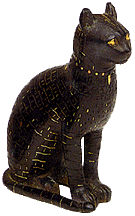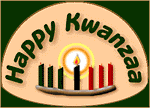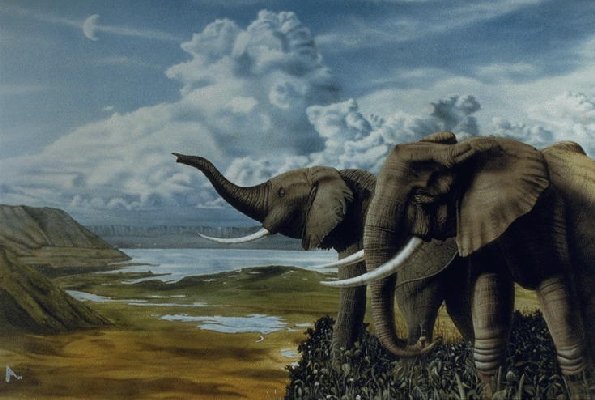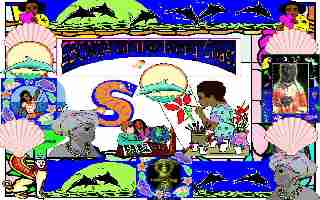Text & Images Here
Are For Your Educational info.
& Viewing Pleasure Only-Thankyou.
Ebonnia's Kwansaa Page


Happy Kwansaa!

The Meaning Of Kwanzaa
Dr. Maulana Karenga was the Founder of the Holiday
of Kwanzaa KWANZAA, an African American holiday which celebrates family,
community and culture, is the fastest growing holiday in the U. S.
An Estimated l8 million Africans celebrate KWANZAA each year around the
world, including celebrants in the U.S., Africa, the Caribbean, South America,
especially Brazil, Canada,
India, Britain and numerous European countries.
The holiday was created
by DR. MAULANA KARENGA,
a scholar-activist who is currently professor and chair of the Department
of Black Studies
at California State University at Long Beach.
Several cities in the U.S. have issued proclamations
in honor of the celebration of KWANZAA.
Among them are Baltimore Buffalo, Los Angeles,
Miami, Newark, New Orleans, New York and Philadelphia.
KWANZAA as an African American
holiday belongs to the most ancient tradition in the world, the African
tradition.
Drawing from and building on this rich and ancient tradition, KWANZAA makes
its own unique contribution
to the enrichment and expansion of African tradition
by reaffirming the importance of family, community and culture.
In the book titled "The
African American Holidav of Kwanzaa:
A Celebration of Family, Community and Culture", Dr. Karenga explains
that KWANZAA is based on ancient African harvest celebrations.
The word KWANZAA comes from the Swahili phrase
"matunda ya kwanzaa" which means "first fruits."
KWANZAA is celebrated seven days;
from December 26 through January 1,
a period which represents the end of an old year
and the beginning of a new one.
This time in African culture is called
"the time when the edges of the year meet,"
which is a time of celebration focus and assessment.
African harvest celebrations
have five basic aspects
which KWANZAA also shares.
They are: 1) ingathering of the people;
2) Special reverence for the Creator and creation,
especially thanksgiving and commitment;
3) Commemoration of the past,
especially paying homage to the ancestors;
4) Recommitment to our highest ethical and cultural values,
especially the Nguzo Saba (The Seven Principles)
and 5) Celebration of the Good of life,
especially family, community and culture.
DR. KARENGA created KWANZAA
to reaffirm African Americans' rootedness in African culture,
to reinforce the bonds between them as a people,
and to introduce and reaffirm the value of the
Nguzo Saba, The Seven Principles of KWANZAA.
The central reason KWANZAA is celebrated for seven days
is to pay homage to The Seven Principles of KWANZAA
which in Swahili and English are:
Umoja(Unity), Kujichagulia (Self-Determination),
Ujima Collective Work and Responsibility),
Ujamma (Cooperative Economics), Nia (Purpose),
Kuumba (Creativity), and Imani Faith).
The principles are also known as
The Seven Principles of African American
community development
and serve as a fundamental value system.
KWANZAA is represented by
seven symbols:
MAZAO (crops), MKEKA (mat), KINARA (candle holder), MISHUMAA SABA seven
candles),
MUHINDI ears of corn), ZAWADI (gifts),
and KIKOMBE CHA UMOJA (unity cup).
The candle holder has seven candles,
one black, three red and three green.
The colors are black for Black people, red for their struggle
and green for the hope and future that come from the struggle.
Each ear of corn represents
the children
in the family and community.
The gifts are primarily for the children,
but other family members can also receive gifts.
The gifts should include a book
and a heritage symbol to stress the ancient
and continuing stress on the value of education
and reaffirm the importance of culture and tradition.
The unity cup is used to pour libation for the ancestors
and it is drunk from as a ritual
to reinforce unity in the family and community.
All seven symbols are put on a MKEKA (straw mat).
The KWANZAA setting piece which include the seven symbols
is placed on a table or any other central location in the home.

The lighting of the candles
begins on the first day of KWANZAA, December 26. The black candle is the
first candle lighted.
The second day of KWANZAA, the black candle is relighted
as well as the first candle to the left, a red candle, December 27.
Each day every candle which has been lighted is relighted
along with the next candle of that day.
Candles are lighted left to right alternately.
The lighting practice is ordered to represent
first the people (the black candle),
then the struggle (the red candle),
then the future and hope (the green candle)
which comes from the struggle.



Back
To Eclectic Holiday House
Home
A Magical Merfolk
& Faekith Vale
Tinkerbella & Kittie's Emerald Forest Isle
Website Design by flwrfey™ © 99





